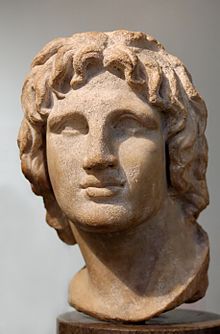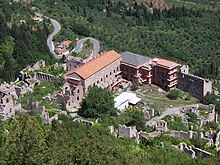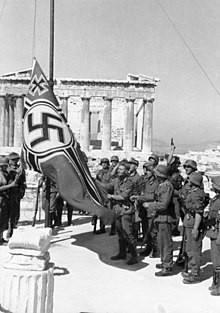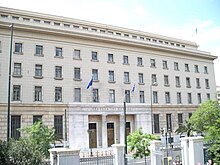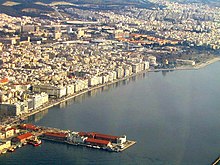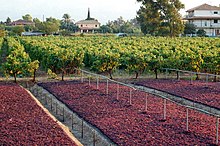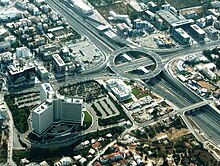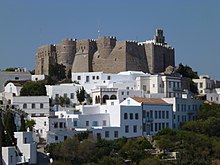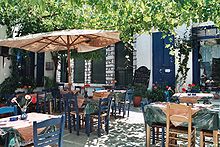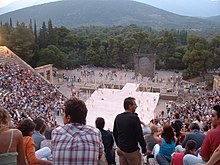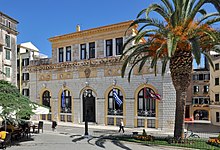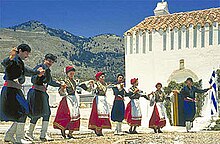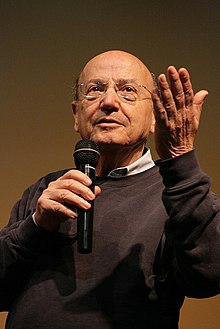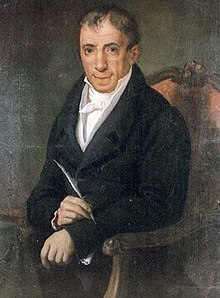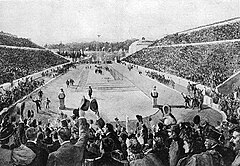Greece
Greece (in modern Greek, Ελδα, Elláda, AFI:[whispering](![]() listen); in ancient Greek, λάς, Hellás), officially Hellenic Republic (in Greek, Δημοκρατία, Ellinikí Dimokratía, AFI:[eliniıci ðimok eclipseaшtia]in Latin, Graecia, Res publica Hellenica or Res publica Graeca), is one of the twenty-seven sovereign states that form the European Union. In this country there are about eleven million people living in a very homogenous society, where Greek is mainly spoken and Orthodox Christianity is practiced.
listen); in ancient Greek, λάς, Hellás), officially Hellenic Republic (in Greek, Δημοκρατία, Ellinikí Dimokratía, AFI:[eliniıci ðimok eclipseaшtia]in Latin, Graecia, Res publica Hellenica or Res publica Graeca), is one of the twenty-seven sovereign states that form the European Union. In this country there are about eleven million people living in a very homogenous society, where Greek is mainly spoken and Orthodox Christianity is practiced.
Athens, the capital, is the most populous city in the country and the second is Thessaloniki. Other cities such as Piraeus, Patras, Heraklion and Larissa are regional political, economic and cultural centers.
Greece is strategically located between Europe, Asia and Africa, and shares land borders to the northwest with Albania, to the north with North Macedonia and Bulgaria, and to the northeast with Turkey. To the east is the Aegean Sea, to the west the Ionian Sea and in the south, the Mediterranean; these three seas bathe its 13,676 km of coastline, the 11th longest coastline in the world. Greek territory is made up of seven archipelagos with some 1,400 islands, of which 227 are inhabited. About 80% of its relief consists of mountains, of which the highest is Mount Olympus, with 2917 meters above sea level.
Modern Greece has its origins in the civilization of ancient Greece, the cradle of Western civilization. For the West it is the birthplace of democracy, Western philosophy, the Olympic Games, literature and the study of history, politics and the most important principles of mathematics and science. The modern Greek state, comprising most of the historical core of Greek civilization, was established in 1830, following a war of independence from the Ottoman Empire. The legacy of its long history is reflected in art, architecture, cuisine, literature, and other cultural aspects.
Currently Greece is a democratic, developed state and has a very high Human Development Index. Greece is also a member of the European Union since 1981 and has used the euro since 2001, it has been part of NATO since 1952 and of the European Space Agency since 2005. It is also a founding member of the United Nations, the OECD and the Black Sea Cooperation Organization. However, Greece is the country that has seen its economy most affected during the economic crisis of 2008-2015, when it reduced its GDP by 25% for five years. Social inequalities, the Gini Coefficient and poverty have also increased a lot. However, the Eurogroup forecast in 2015 an increase in Greek GDP in the following years.
Etymology
The names used to refer to the nation of Greece and the Greek people vary depending on language, location, and culture. Although the Greeks call the country Hellás or Ellada (in Greek, Ἑλλάς or Ελλάδα) and its official name is the Hellenic Republic, in Spanish it is known as Grecia, which comes from the Latin term Graecia. This was used by the Romans, it literally means "the land of the Greeks" and is derived from the Greek name Graikós (Γραικός), whose etymology is still unknown. In Spanish the term Hélade is occasionally used to refer to both modern and ancient Greece. Aristotle was the first to use the name graeci (γραικοί, i.e. "Greeks") in his work Meteorology, where he states that the area near Dodona and Acheloos was inhabited by the Selli and by a people formerly called graeci, but who in his time were called Hellenes.
History
Early settlements and Ancient Greece
The oldest evidence of human presence found in the territories of present-day Greece is found in the Petralona cave, in the Chalcidice peninsula, where a skull known as the Petralona man was found, whose dating is disputed. Greek territory there are vestiges of settlements from the three stages of the Stone Age —Paleolithic, Mesolithic and Neolithic—; some sites, such as the Franchthi cave, were occupied during all three of these periods. Since the country lies on the route by which agriculture spread from the Near East to Europe, Neolithic settlements in Greece are the oldest in the world. continent, as they date from the seventh millennium BC. C.
The first civilizations of Europe arose in what is now Greek territory, which is why it is considered the birthplace of Western civilization. The first to appear were the Cycladic civilization on the islands of the Aegean Sea (around from 3200 BCE), the Minoan civilization on Crete (2700-1500 BCE) and the Mycenaean civilization on the mainland (1900-1100 BCE). These societies possessed a writing system: The Minoans used an undeciphered one known as Linear A, while the Mycenaeans developed Linear B, an early form of Greek. The Mycenaeans gradually absorbed the Minoans, but their culture violently collapsed around 1200 BC. C., during a period of regional instability known as the Bronze Age Collapse. This led to an era known as the Dark Ages, for which no written record survives.
Traditionally, the end of the Dark Age, and the beginning of the Archaic Period, is set in 776 BC. C., the year in which the first Olympic Games were held. It is thought that between the centuries VIII and VII a. C. Homer wrote the Iliad and the Odyssey, the founding texts of Western literature. With the end of the Dark Ages, various kingdoms and city-states arose, the which extended to the coasts of the Black Sea, southern Italy (Magna Graecia) and Asia Minor. These states and their colonies reached a high level of prosperity that gave way to an unprecedented cultural flourishing—a period known as classical Greece—most evident in architecture, theatre, science, mathematics, and philosophy. In 508 B.C. C., Cleisthenes introduced the world's first democratic system in Athens.
By 500 B.C. C. the Persian Empire controlled the territory between the present Iran until the zones that today comprise of the north of Greece, Macedonia of the North, the south of the Ukraine, Bulgaria and Rumania, reason why it became a threat for the Greeks. The Hellenic city-states located in Asia Minor failed in their attempts to drive out the Persians; in 492 B.C. The Persian army invaded the states of mainland Greece, but was forced to withdraw after its defeat at the Battle of Marathon in 490 BC. C. Ten years later they launched a second offensive. Despite the heroic resistance of the Spartans and other Greeks at the Battle of Thermopylae, the Persian forces managed to reach Athens.
After a series of Greek victories between 480 and 479 B.C. In the battles of Salamis, Plataea, and Mycala, the Persians were forced to withdraw a second time. These military conflicts, known as the Medic Wars, were largely led by Athens and Sparta. The fact that Greece was not a unified country gave rise to several conflicts between the Hellenic states.
Within these, the most important confrontation was the Peloponnesian War (431-404 BC), where the victory of Sparta marked the end of the supremacy of the Athenian Empire over Ancient Greece. of Leuctra (371 BC) gave Thebes hegemonic power, but shortly after it was taken from him by Macedonia. This kingdom managed to unify the Greek world in the League of Corinth - also known as the "Hellenic League" - under the command of Philip II, leader of the first unified Greek state in history.
After the assassination of Philip II, his son Alexander the Great assumed leadership of the Corinthian league, and in 334 B.C. C. he launched an invasion of the Persian Empire with the combined forces of the Greek states. Four years later and after being victorious in the battles of Granicus, Issos and Gaugamela, the Greeks marched on Susa and took Persepolis, the ceremonial capital of Persia. The empire created by Alexander the Great stretched from Greece in the west to present-day Pakistan. in the east and Egypt in the south.
The sudden death of Alexander the Great in 323 B.C. C., led to the collapse of the Empire, which divided into several kingdoms: the Seleucid Empire, Ptolemaic Egypt, the Greco-Bactrian Kingdom and the Indo-Greek Kingdom. Many Greeks migrated to Alexandria, Antioch, Seleucia, and many other Hellenistic cities in Asia and Africa. Although the political unity of Alexander the Great's Empire could not be maintained, it brought dominance of Hellenistic civilization and the Greek language to all countries. territories conquered for at least two centuries, and in the case of some eastern Mediterranean regions, for a longer period.
Hellenistic and Roman Periods
Alexander the Great (bust 2nd century BC, Alexandria). He continued his father Philip II's plan to assert dominance over Greece, extended the territories to southeastern Europe, and set in motion in a Panhellenic plan to wrest empire from Persia: the Greek cities of Asia Minor to Egypt, and finally conquered the Persian empire, all the way to Afghanistan and the limits of India. He passed away at thirty-two years of age.
In Greece, the death of Alexander the Great was followed by a period of turmoil. In 276 B.C. The Antigonid dynasty, descendants of one of Alexander's generals, seized power in Macedonia and most of the Greek city-states. -transform:lowercase">II a. The involvement of the Roman Republic in the internal affairs of the Hellenes led to the Macedonian Wars. Macedon's defeat at the Battle of Pydna (168 BC) ended Antigonid rule in Greece. In 146 BC. C. Rome annexed Macedonia as a province, and the rest of its territory became a Roman protectorate.
The process ended in 27 BC. C. when the Roman Emperor Caesar Augustus took over the rest of Greece to make it the senatorial province of Achaia. Despite their military supremacy, the Romans admired and were strongly influenced by the achievements of Greek culture, hence the famous Horace's phrase: Greecia capta ferum victorem cepit ("conquered Greece conquered the conquering barbarian"). Greek mathematics, science, and technology are generally considered to have reached their apogee during the Hellenistic period.
Greek-speaking communities of the Hellenized East played a key role in the spread of Christianity during the II and III, as several early Christian leaders and authors, such as Paul of Tarsus, spoke Greek. However, the Greek population as such had a tendency to cling to paganism and the country was not one of the main pillars of early Christianity: in fact, some of the practices of ancient Greek religion continued until the end of the century IV, and some areas of southeastern Peloponnese did not convert to Christianity until the X.
Medieval Period
After the division and fall of the Roman Empire, Greece became part of the Byzantine Empire, the Eastern Roman Empire, which lasted from the 17th century V until 1453. Its capital was located in Constantinople, its language and literature were based on the Greek language, and the predominant religion was Orthodox Christianity.
Since the IV century, the Balkan territories of the empire, including Greece, suffered from the constant onslaught of barbarian invasions. Raids and devastation by the Goths and Huns during the IV and V, and the Slavic invasion of the VII century, caused a collapse dramatic rise of imperial authority on the peninsula. After the Slavic invasion, the imperial government maintained control only of the islands and some coastal areas, particularly cities such as Athens, Corinth, and Thessaloniki, while some of the mountainous inland areas they showed some resistance to the occupation and continued to recognize imperial authority. A number of Slavic settlements are believed to have existed outside these regions, although on a much smaller scale than previously thought.
In the late 8th century century, the Byzantine Empire began to gradually recapture its lost territories, and by the IX most of present-day Greece was again under Byzantine control. The great migrations of Greeks from Sicily and Asia Minor towards the Balkan peninsula facilitated this process, at the same time that many of the Slavs were captured and relocated to Asia Minor and those who remained in Greece were assimilated. Over the centuries XI and XII the return of peace and stability to the Greek territory were the foundations for strong economic growth, much larger than that of the Anatolian region.
After the Fourth Crusade and the fall of Constantinople to the Latins in 1204, most of Greek territory fell to the Franks—a period known as "Francocracy"—and some islands were taken over by Venice. In 1261 the reestablishment of the Byzantine Empire in Constantinople made possible the recovery of almost all of these regions. However, the Frankish principality of Achaia in the Peloponnese remained a major regional power until the 14th century, while several archipelagos they remained under the control of Genoa and Venice.
In the 14th century the Byzantine Empire lost several parts of present-day Greece to Serb and Ottoman attacks. In the early 15th century century, the Ottoman advance meant that Byzantine control over Greece was reduced to the Despotate of the Morea in the Peloponnese. After the fall of Constantinople to the Ottomans in 1453, the Morea was the last remnant of the Byzantine Empire to oppose the Turkish invasion, holding out until 1460. With the Ottoman conquest, many Greco-Byzantine scholars —responsible for preserving much of the knowledge of Classical Greece— emigrated to the West taking with them a large number of literary works, and with them contributed to the development of the Renaissance.
Ottoman Period
By the end of the 15th century, most of Greece and the Aegean islands were under Ottoman control, while that Cyprus and Crete remained under Venetian rule and did not become part of the Ottoman Empire until 1571 and 1670, respectively. The only part of the Greek-speaking world not conquered by the Turks were the Ionian Islands, which remained under Venetian control until its conquest by the French First Republic in 1797 and then passed to the United Kingdom in 1809 until its unification with Greece in 1864.
The Greeks of the Ionian Islands and Constantinople lived in prosperity, even those who inhabited that city reached important positions within the Ottoman administration. On the contrary, most of the Greek people suffered the economic consequences of the Turkish conquest. The Turks set high taxes, and in later years enacted a policy of creating hereditary titles, virtually turning rural dwellers into serfs.
The Ottoman government considered the Orthodox Church of Greece and the Ecumenical Patriarchate of Constantinople as the main authorities of the entire Orthodox Christian population of the Empire, regardless of ethnicity. Although the Ottoman state did not force the population to convert to Islam, Christians faced various forms of discrimination, aimed at pointing out their inferior status within the Empire. This discrimination against Christians, added to the mistreatment by the local Ottoman authorities, were the cause of many conversions to Islam, at least superficially. In the 19th century, many "crypto-Christians" returned to their old religious practices.
The nature of Ottoman administration in Greece varied from place to place, but was always characterized by negligence and arbitrariness. Some cities had sultan-appointed governors, while others, such as Athens, were self-governing municipalities. The mountainous regions in the interior remained virtually autonomous from the central Ottoman government for several centuries.
When military conflicts broke out between the Ottoman Empire and other countries, the Greeks usually rose up against the Turks, with a few exceptions. Before independence, the Greeks fought against the Ottomans in several engagements. Notable were the Greek participation in the Battle of Lepanto in 1571, the Epirus peasant revolts of 1600-1601, the Morean War of 1684-1699, and the Orlov rebellion of 1770, the latter instigated by the Russian Empire. uprisings were harshly suppressed by the Ottoman army.
The 16th and XVII are considered by some authors as a kind of "dark age" in Greek history, since the hope of expelling the Ottomans seemed remote. Even the Turkish army tried to occupy the Ionian islands on several occasions; Corfu withstood three major sieges in 1537, 1571 and 1716. During the 18th century, a merchant class arose on this island. rich and scattered Greek. These traders dominated trade within the Ottoman Empire, establishing communities throughout the Mediterranean, the Balkans, and Western Europe. Although Turkish rule had left Greece out of the great European intellectual movements such as the Protestant Reformation and the Enlightenment, these Ideas, along with the ideals of the French Revolution and romantic nationalism, began to penetrate the Greek world thanks to this mercantile diaspora. At the end of the century XVIII, Rigas Feraios, the first revolutionary to seek the creation of an independent Greek state, published in Vienna a series of documents relating to the independence of Greece, including a national anthem and the first detailed map of the country; he was assassinated in 1798 by agents of the Ottoman Empire.
War of Independence
In 1814, a secret organization called Filikí Etería —in Greek: Society of Friends— was founded, whose goal was the independence of Greece. Filikí Etería planned to launch a revolution in the Peloponnese, the Danube principalities, and Constantinople. The first of these revolts began on March 6, 1821 in the Danube Principalities under the leadership of Alexandros Ypsilantis, but was quickly put down by the Ottomans. Events in the north encouraged the Greeks in the Peloponnese to take up arms and on March 17, 1821 they declared war on the Ottomans.
By the end of the month, the Peloponnese was embroiled in a rebellion against the Ottomans, and by October 1821, the Greeks, led by Theodoros Kolokotronis, had captured Tripolitsa. The Peloponnesian rebellion was immediately followed by other movements in Crete, Macedonia and Central Greece but all of these were quickly put down. Meanwhile, a makeshift Greek Navy defeated the Ottoman Navy in the Aegean Sea, thereby preventing Turkish reinforcements from arriving by sea. In 1822 and 1824 the Turks and Egyptians invaded the islands, including Chios and Psara, where they massacred the civilian population. For this reason, Western European public opinion turned in favor of the Greek rebels.
However, problems began to arise between the various Greek factions, leading to two consecutive civil wars. For his part, the sultan negotiated with the Egyptian governor Mehmet Ali, who agreed to send his son Ibrahim pasha to Greece with an army to put down the rebellion in exchange for certain territories. Ibrahim arrived in the Peloponnese in February 1825 and obtained a immediate victory: by the end of that year, most of the region was under Egyptian control, and the city of Mesolongi—besieged by the Turks since April 1825—fell a year later. Although Ibrahim was defeated at Mani, he managed to drive the rebels out of much of the Peloponnese and regained control over Athens.
After years of negotiations, three of the Great Powers—Russia, the United Kingdom, and France—decided to intervene in the conflict, with each nation sending a fleet to Greece. After learning that an Ottoman-Egyptian fleet was heading to the island of Hydra, the allied fleet intercepted them at Pylos. After a week of tension, the battle that ended in the destruction of the Ottoman-Egyptian fleet began. A French expeditionary force oversaw the evacuation of the Egyptian army from the Peloponnese, while the Greeks went on to take Central Greece in 1828. After two years of negotiations, the First Hellenic Republic received international recognition in the London Protocol.
19th century
In 1827 Ioannis Kapodistrias was elected as the first governor of the new Republic. However, after his assassination in 1831, the Great Powers established a monarchy headed by Otto I of the House of Wittelsbach. In 1843, an uprising forced the king to promulgate a constitution and establish a representative assembly.
Due to his authoritarian attitude, he was dethroned in 1862 and, a year later, replaced by Prince William of Denmark, who took the name George I and brought the Ionian Islands with him by the Treaty of London, a coronation gift by the United Kingdom. In 1875 Charilaos Trikoupis, credited with a major improvement in the country's infrastructure, limited the monarchy's power to interfering in the assembly and promulgating the rule of confidence for the prime minister. Corruption and increases in spending by Trikoupis to build necessary infrastructure works for the country, such as the Corinth Canal, weakened the fragile Greek economy. In 1893 the government declared bankruptcy and accepted the demands of an International Financial Control Authority to pay its debtors.
Another political problem of the 19th century, unique to Greece, was the question of language. The general population spoke a form of Greek called demotic. Many elite intellectuals viewed it as a peasant dialect and were determined to restore ancient Greek to its glory. Government documents and newspapers were published in katharévousa ("purified") Greek, a variant that few people could read. Liberals promoted the recognition of Demotic as the national language, but Conservatives and the Orthodox Church were against such a declaration. The situation reached the point where, when the New Testament was translated into Demotic in 1901, a series broke out. of demonstrations in Athens that ended up overthrowing the government, known as Evangeliaka. The language problem persisted in the political environment until the 1970s.
However, all Greeks were united in their determination to liberate the Greek-speaking provinces from the Ottoman Empire. In Crete, a prolonged revolt between 1866-1869 exacerbated nationalist sentiments. When the Russo-Turkish war of 1877-1878 broke out, the Greek people were in favor of supporting the Russians; but due to the precarious economic situation and the possibility of British intervention, Greece never entered the war. When the Russians defeated the Turks in 1881, the Treaty of Berlin forced the Empire to cede Thessaly and some parts of Epirus to Greece, but not the island of Crete.
For their part, the Cretans continued to orchestrate a series of rebellions, and in 1897 the Greek government of Theodoros Deligiannis, yielding to popular pressure, declared war on the Ottomans. Thus, in the Greco-Turkish War of 1897 the Ottomans defeated the poorly trained and equipped Greek army. Thanks to the intervention of the Great Powers, Greece only lost a small part of its territory on the border with Turkey, while an autonomous state was established in Crete headed by Prince George of Greece.
20th and 21st centuries
By the end of the Balkan Wars, the area and population of Greece had increased. In the following years, the struggle between King Constantine I and Prime Minister Eleftherios Venizelos for control of foreign policy dominated the political arena and divided the country. During World War I, Greece came to have two governments: one pro-German pro-king, located in Athens; the other pro-British in favor of Venizelos, based in Thessaloniki. The two governments were united in 1917, when Greece officially entered the war on the side of the Triple Entente.
Shortly after the end of World War I and with the partition of the Ottoman Empire, Greece tried to extend its territories into Asia Minor, which at that time was a region with a large population of Greek origin, but was defeated in the Greek War -Turkish from 1919-1922. As a consequence of the conflict and the signing of the Treaty of Lausanne, both countries suffered a great population exchange: the Greeks who lived in Turkish territory emigrated to Greece, and vice versa. In addition, thousands of Pontic Greeks died during the war, in an episode often referred to as the genocide of the Pontic Greeks, nearly half a million Pontic Greeks were killed by the Turks. The following years were characterized by instability, coupled with the daunting task of integrating more than 1.5 million Greeks refugees from the territories that were held by Turkey within the society of the Greek Republic. The population recognized as Greek of Istanbul (in Greek called Byzantium or Constantinople for millennia), went from 300,000 inhabitants in 1900 to about 3,000 in 2001.
Following the catastrophic events in Asia Minor, a referendum was held in 1924 to abolish the monarchy and proclaim the Second Hellenic Republic. Prime Minister Georgios Kondilis seized power in 1935 and virtually abolished the republic by bringing back the monarchy with another referendum. The following year Ioannis Metaxas staged a coup and established a dictatorship known as the August 4 regime. Despite being a fascist-style dictatorship, Greece remained on good terms with the United Kingdom and stayed away from the Axis countries.
On October 28, 1940, Italy demanded the surrender of Greece, but the Greek government refused and declared war. In the Greco-Italian War, Greece repelled Italian forces into Albania, the first victory for the Allies in a land battle. Shortly thereafter, however, the country was defeated by German forces during the Battle of Greece. Although the German occupation had to deal with Greek resistance, more than 100,000 civilians died of starvation during the winter of 1941-1942, and the vast majority of Greek Jews were deported and murdered in Nazi concentration camps.
Following its liberation, Greece entered a civil war between communist and anti-communist forces, which brought with it economic weakening and political tensions between right-wing and left-wing parties. After the anti-communist victory, the following two decades were characterized by a great marginalization of leftists in the political and social spheres, but also by rapid economic growth fueled in large part by the Marshall Plan.
In July 1965, the resignation before King Constantine II of the centrist government of George Papandreou created a political upheaval that culminated in the coup d'état on April 21, 1967 by a group of colonels that established a military dictatorship. On November 17, 1973, the Athens Polytechnic's brutal suppression of the revolt weakened the regime, so a council appointed Brigadier Dimitrios Ioannidis as dictator. On July 20, 1974, as Turkey invaded Cyprus, the regime collapsed.
Former Prime Minister Constantinos Karamanlís was invited to return from his exile in Paris and usher in the Metapolitefsi era. On the first anniversary of the Athens Polytechnic revolt, the first multi-party elections since 1964. A democratic constitution was promulgated on 11 June. Andreas Papandreou founded the Panhellenic Socialist Movement (PASOK) in response to Karamanlis's conservative New Democracy party. Since then, both parties alternated in government until 2015.
Greece became the tenth member of the European Economic Community—the predecessor of the European Union—on January 1, 1981, fueled by a period of steady growth. Multiple investments in industrial enterprises and infrastructure, as well as Funds from the European Union and growing revenues from tourism, transportation, and the service sector raised the country's living standards to unprecedented heights. Although relations with Turkey had traditionally been quite tense, they improved after two earthquakes hit both countries in 1999. Greece adopted the euro as its currency in 2001 and hosted the 2004 Athens Olympics.
The Greek economy was hit hard by the 2008 Great Recession and was the main player in the 2010 euro crisis., with the help of the investment bank Goldman Sachs, some macroeconomic data, including the true amount of its foreign debt and the public deficit. The huge real deficit led to significant cuts in the public sector. This, together with the serious economic crisis that for more than five years reduced the country's GDP by more than a quarter of that of 2008, placed unemployment at a peak of 27%, the population in poverty or at risk of suffering from it it exceeded 35% and three million people were left without healthcare, among other indicators. In response, there were demonstrations and riots in the main Greek cities and more than thirty general strikes between 2009 and 2014. (see Sovereign debt crisis in Greece). In January 2015 In the context of the unprecedented crisis in the country, the SYRIZA party won the parliamentary elections, marking the first time in the history of Greece that a party to the left of social democracy reached the government democratically.
Government and politics
Greece is a parliamentary republic where the head of state is the President of the Republic, who is elected by Parliament for a five-year term. The constitution was drafted and promulgated by the Fifth Revision Parliament of Hellenes and entered into force in 1975, after the fall of the military junta that had governed the country since 1967. Since then, three amendments have been made: in 1986, 2001 and 2008. The constitution, which consists of 120 articles, establishes the division of powers in the executive, legislative and judicial branches, and stipulates extensively and specifically the guarantees of civil liberties and social rights.
According to the constitution, the executive power is represented by the President of the Republic and his cabinet.The 1986 constitutional amendment limited many of the president's tasks, and now most of his functions are only ceremonial; therefore, most of the political power rests in the hands of the prime minister. The position of the prime minister, the head of government of Greece, belongs to the current leader of the political party that wins a vote of confidence in Parliament. The President formally appoints the Prime Minister and, based on his recommendations, elects or dismisses the other members of the Government.
The legislature is represented by a unicameral parliament made up of 300 members elected by the people. The statutes approved by Parliament are promulgated by the President of the Republic. Parliamentary elections are held every four years, but the president he is obliged to dissolve Parliament a little earlier, during the cabinet election, in order to deal with a national problem of exceptional importance. The President is also obliged to dissolve Parliament earlier if the opposition passes a motion of no confidence. Since democracy was restored, the Greek two-party system has been dominated by the liberal-conservatives of New Democracy (Greece) (ND) and the social democrats of the Panhellenic Socialist Movement (PASOK).
The judiciary is independent of the executive and legislative branches, and is headed by three Supreme Courts: the Court of Cassation, the Council of State and the Court of Accounts, the highest courts in the country. The judicial system is also made up of civil courts, which judge civil and criminal cases, and administrative courts, which resolve disputes between citizens and administrative authorities.
The Hellenic Police is the national police force of Greece. It is a very large agency whose responsibilities range from vehicular traffic control to actions against terrorism. It was established in 1984 by Law 1481/1-10-1984, as a result of the merger of the forces of the Gendarmerie and the City Police.
Foreign Relations
The Ministry of Foreign Affairs is in charge of Greece's foreign policy. The Foreign Minister states that the main objectives of the ministry are: to represent Greece before other states and international organizations; safeguard the interests of the Greek state and its citizens abroad; promote Greek culture; seek closer relations with the Greek diaspora; and promote international cooperation. Additionally, Greece developed a regional foreign policy in which it pledges to promote peace and stability in the Balkans, the Mediterranean, and the Middle East.
In turn, the ministry identifies three situations that are of particular importance to the Greek government: Turkey's claims to what the ministry defines as "Greek sovereignty over the Aegean Sea and related airspace"; the legitimacy of the Turkish Republic of Northern Cyprus on the island of Cyprus; and the dispute over the name of Macedonia with the small Balkan country that shares its name with Greece's largest and second most populous region. Greece is a member of numerous international organizations, including the Council of Europe, the Union of the Mediterranean, the North Atlantic Treaty Organization and the United Nations, of which it is a founding member.
Armed Forces
The Greek Armed Forces are controlled by the Greek National Defense General Staff and the Ministry of National Defence. The armed forces consist of three branches: the Army, the Navy and the Air Force. In addition to the above, Greece also has the Hellenic Coast Guard for law enforcement at sea and search and rescue operations.
Military service is compulsory in Greece for all men. Although women are exempt from it, they can enlist in the military. All men between the ages of 19 and 45 must serve a total of nine months or one year. However, as the armed forces become more and more of a professional army, the government is considering the possibility of reducing or abolishing compulsory military service.
The Coast Guard may require the service of all men between the ages of 18 and 60 who live in strategically sensitive areas. This service is not full time and is paid. As a member of NATO, Greece participates in military exercises under the patronage of its allies. In 2012 Greece invested more than US$7 billion in the military, that is, 1.7% of its GDP.
Human Rights
Greece remains fully interested in human rights and the issue of global warming. In terms of human rights, regarding membership of the seven bodies of the International Bill of Human Rights, which include the Human Rights Committee (HRC), Greece has signed or ratified:
Territorial organization
For administration, Greece is divided into seven decentralized administrations (αποκεντρωμένες διοικήσεις), divided in turn into thirteen peripheries (περιφέρειες), you are in seventy and four peripheral units (περιφερειακές. There is a separate region, Mount Athos, which has its own autonomy under Greek sovereignty.
|
Geography
Greek territory is mainly mountainous and forms a peninsula that juts out from the southern tip of the Balkans and ends in the Peloponnese peninsula, which is separated from the rest of the mainland by the Corinth Canal, which runs through the Isthmus of Corinth. Due to its rugged coastline and numerous islands, Greece has the 10th longest coastline in the world, at 13,676 km. To the north, it shares a border with Albania, North Macedonia and Bulgaria, and to the northeast with Turkey; its land borders span more than 1,160 km. The country lies approximately between latitudes 34° and 42° N and longitudes 19° and 30° E.
Greek territory also comprises between 1,200 and 6,000 islands—the number depends on the definition of an island—227 of which are inhabited. Of these, Crete is the largest and most populous island; Euboea, separated from the mainland by the 60 m of the Euripus Strait, is the second largest, followed by Rhodes and Lesbos.
Commonly, the Greek islands are grouped into six groups: the Saronic Islands, located in the Saronic Gulf, near Athens; the Cyclades, a large and dense collection that occupies the central part of the Aegean Sea; the North Aegean islands, a scattered group off the western coast of Turkey; the Dodecanese, another collection scattered in the southeast between Crete and Turkey; the Sporades, a small group on the northeastern coast of Euboea; and the Ionian Islands, located to the west of the mainland in the Ionian Sea.
Between 70% and 80% of the Greek territory is covered by mountains and hills, making it one of the most mountainous countries in Europe. Mount Olympus, the mythical abode of the Greek gods, is the point highest in the country, since the Mytikas peak reaches 2917 m s. no. m.. In western Greece there are several lakes and swamps, but the terrain is dominated by the Pindus mountain range. The Pindus, a continuation of the Dinaric Alps, reaches 2637 m a.s.l. no. m. on Mount Smolikas—the second highest point in Greece—and has historically been a major barrier to east-west cross travel between Thessaly and Epirus.
The Pindus mountain range continues its course towards the center of the Peloponnese, crossing the islands of Kythera and Antikythera towards the southwest of the Aegean, until reaching the island of Crete, where it ends. The islands of the Aegean Sea are the tops of seamounts, which were once the continuation of the continental ridges. The Pindus is characterized by its high and rugged summits, often interrupted by numerous canyons and a great variety of karst landscapes. The Guinness Book of Records recognizes the Vikos Gorge, part of the Vikos-Aoos National Park, as the deepest canyon in the world.
In northeastern Greece lies another high-altitude mountain range, the Rhodope Mountains, which cut through the region of East Macedonia and Thrace. This area is covered by several extensive and lush forests, including the famous Dadia forest. The great plains are generally found in the regions of Thessaly, Central Macedonia and Thrace. As one of the few arable lands in the country, these regions make up an important part of the economy.
Climate
The climate of Greece is largely Mediterranean with mild, wet winters and hot, dry summers. This climate prevails in all coastal regions, including Athens, the Cyclades, the Dodecanese, Crete, the Peloponnese, the Ionian Islands, and parts of the Central Greece region. The Pindus mountain range greatly affects the country's climate, as the areas to the west of the mountains they are considerably wetter than the rest, due to the greater exposure to the southwestern systems that bring with them more humidity, while the eastern areas suffer from the effect of the orographic shadow.
The mountainous areas of northwest Greece—parts of Epirus, Central Greece, Thessaly, Western Macedonia—as well as the hills of the central parts of the Peloponnese—including some areas of Achaia, Arcadia, and Laconia—have an alpine climate with heavy snowfall. The interior of the northern regions, such as Western Macedonia and Eastern Macedonia and Thrace, have a temperate climate with hot, dry summers and cold, wet winters with frequent thunderstorms. Snowfall occurs every year in the north and areas mountainous, even small snowfall can occur in regions further south and with lower altitude, such as Athens.
Flora and fauna
30% of Greece is covered by forests with vegetation, which varies from alpine conifers to Mediterranean vegetation. According to the WWF, the territory of Greece is divided into eight different ecoregions. Temperate broadleaved forest is divided into the Balkanic mixed forest of the northern lowlands and the mixed forest of the Rhodope Mountains. The Mediterranean forest can be classified into four types: Illyrian deciduous forest in the extreme northwest, mixed forest of the Pindus Mountains, Mediterranean forest of Crete, and the sclerophyllous and mixed forest of the Aegean and western Turkey.
Thanks to the variety of climates and landscapes, there are more than 5,500 species of plants in Greece. In the lowlands it is common to find fruit trees such as orange, olive, date, almond, pomegranate, fig and grapevines. Pine, oak and chestnut trees abound on higher ground. In mountainous areas above 1070 m s. no. m. trees such as beech and fir grow.
In the early 2000s, there were 116 mammalian species, 422 bird species, 126 fish species, 60 reptile species, and 20 amphibian species, although these numbers are expected to decline. In the seas surrounding the Mainland Greece is inhabited by some unique marine species such as pinniped seals and loggerhead turtles. For its part, dense forests inhabit some endangered mammal species such as the brown bear, lynx and roe deer. The wild goat, extinct in the rest of Europe, still lives in some mountains and islands in the country.
Rivers
Greece's rivers are small and often flow into the Ionian and Adriatic Seas. The ancient Greeks treated their rivers like gods for their exceptional beauty. The longest rivers in Greece are the Evros, the Axiós and the Haliacmon.
Economy
According to data from the International Monetary Fund (IMF), Greece's economy is the 50th largest in the world, at $226.774 billion by nominal GDP or purchasing power parity, respectively. Furthermore, Greece is the 15th largest economy among the 27 members of the European Union.
Greece is considered a developed country with high living standards. Its economy is made up of the service sector (85%), industry (12%) and the primary sector (3%). The most important Greek industries include tourism - with 15.5 million international tourists in 2012, the seventh most visited country in the European Union and 16th internationally—and the maritime industry—with 16.2% of the total world capacity, the Greek merchant navy is the largest in the world—Greece is also a major producer of raw materials within the European Union, especially in relation to fishing.
With an economy larger than all the Balkan countries combined, it is also the largest economy in the region, and a major regional investor. Greece is the second largest investor in Albania, the third largest in Bulgaria, Romania and Serbia and North Macedonia's most important trading partner. It is estimated that every week a Greek bank opens a new branch somewhere in the Balkans.
Greece is classified by the IMF as a high-income advanced economy. It is a founding member of the Organization for Economic Co-operation and Development (OECD) and the Black Sea Economic Cooperation (CEMN). In 1979 it acceded to the European Economic Community and its common market, a process that ended in 1982. In January 2001 it adopted the euro to replace its old currency, the drachma, at an exchange rate of 340.75 drachmas per euro.
Between 2008 and 2016, Greece's GDP fell by almost 25%. Public debt went from 103.1% of GDP in 2007 to 181.2% in 2018. IMF projections estimate that it will reach 293.6% of GDP in 2060. The country cut public spending by 32.4% during the crisis. These fiscal austerity measures have been accompanied by structural reforms, such as the weakening of labor laws, the suspension of collective bargaining rights, and the reduction of the minimum wage. Pensioners have also seen their pensions cut between 14 and 40%. The number of homeless people has increased by 20-25%.
Conservative Prime Minister Kyriákos Mitsotákis launches a wave of privatizations in 2019, including tourism infrastructure, coastal land, and state shares in gas and electricity companies and the Athens airport. The anti-fraud brigade of the Tax Agency was abolished and its employees were integrated into the Ministry of Finance. The government also approved a labor law reform that allows employers to fire their employees without having to give reasons for their decision or inform those fired. Finally, a tax reform is being implemented aimed at turning the country into "a paradise for billionaires and the richest citizens", notes the Financial Times. The aim is to attract investment by offering low tax rates. In addition, a clause will protect the beneficiaries of this fiscal policy from possible policy changes by future governments. In 2019, one in three Greek employees works part-time with a net salary of 317 euros and 34.8% of the population is at risk of poverty or social exclusion. Inequality has also increased. Tax evasion will cost the Greek state 30 billion euros per year.
Financial crisis
By the end of 2009, as a result of a combination of local and international factors, the Greek economy faced its most severe crisis since the restoration of democracy in 1974, as the government corrected its deficit figure from a estimated from 6% of GDP to 12.7%.
In early 2010, it was discovered that the governments of Greece, Italy and other European countries, with the assistance of Goldman Sachs, JPMorgan Chase and other banks, developed various financial instruments that allowed them to hide all their loans. In this way, each country was able to spend more of its budget and at the same time continue to respect the deficit limit imposed by the European Union. In May 2010, the Greek government deficit was revised again and was estimated to have reached 13.6% of GDP, the second highest deficit in the world, only after Iceland's. According to a series of estimates, public debt was predicted to rise as high as 120% of GDP during 2010.
As a consequence, there was a crisis of international confidence in Greece's ability to pay its public debt. To prevent this situation, in May 2010 other eurozone countries, together with the IMF, agreed on a rescue package in which they would deliver to Greece around €45 billion in bonds immediately, to later continue to grant more loans until a total of €110 billion. To secure these funds, Greece had to adopt a series of extreme austerity measures to keep its deficit under control.
In 2011 it became apparent that the bailout would be insufficient, so a second package of €130 billion was approved for 2012, subject to conditions stringent, including financial reforms and further austerity measures. In 2013, Greece ran a surplus in the primary government budget. In April of the following year, the country returned to the global bond market and according to the IMF, after five years of declines, GDP is expected to grow by 0.6% for 2014.
Agriculture
In 2010, Greece was the leading producer of cotton (183,800 t) and pistachios (8,000 t) in the European Union; it was the second-largest producer of rice (229,500 t) and olives (147,500 t); the third in figs (11,000 t), almonds (44,000 t), tomatoes (1,400,000 t) and watermelons (578,400 t); and the fourth in tobacco (22,000 t). Agriculture contributes 3.8% of GDP and employs 12.4% of the labor force.
Greece is one of the main beneficiaries of the European Union's Common Agricultural Policy. As a result of its accession to the European Community, much of its agricultural infrastructure was upgraded to increase its production. Between 2000 and 2007 the number of organic farms increased by 885%, the highest increase within the European Union.
Maritime Industry
The maritime industry is a key element of the Greek economy dating back to ancient times. It accounts for 4.5% of GDP, employs around 160,000 people (4% of the workforce) and represents a third of the country's trade deficit.
During the 1960s, the size of the Greek merchant fleet nearly doubled, mainly due to investments made by shipping magnates Aristotle Onassis and Stavros Niarchos. The foundation of the modern Greek shipping industry was established after World War II, when Greek businessmen were able to profit from boats sold by the United States government, thanks to the Boat Sales Act of the 1940s.
According to the United Nations Conference on Trade and Development, in 2013 the Greek merchant navy was the largest in the world, with 15.1% of total world capacity, a decrease of 16.2% from 2011. It also has the largest total tonnage in its merchant fleet, at 244 million dwt.
In terms of number of vessels, the Greek merchant marine is the fourth largest internationally, with 3,695 vessels—825 of them are registered in Greece and the remaining 2,870 in other ports. In terms of categories, Greece it has the largest number of freighters and bulk carriers, and ranks fourth in number of container ships. However, the current fleet is much smaller compared to the 1970s, when it numbered more than 5,000 ships. In addition, the The total number of ships flying the Greek flag is 885, that is, 5.3% of the world DWT.
Tourism
A significant percentage of national income comes from tourism, which contributes 16% of GDP. According to Eurostat statistics, Greece received more than 17.1 million tourists in 2011, which represents a decrease of the 17.7 million reported in 2007.
In 2007, the vast majority of tourists came from the European continent, some 15.7 million. Of these, visitors from Germany —2.2 million— and the United Kingdom —1.8 million— were the most numerous. In 2010, the most visited region in Greece was Central Macedonia, which accounted for 18% of the total tourist flow -3.6 million tourists-, followed by Attica -2.6 million- and the Peloponnese -1.8 million—
In 2012, Lonely Planet ranked Thessaloniki as the fifth best city to party in the world, comparable to other cities such as Dubai and Montreal. In 2014, Travel + readers Leisure voted Santorini "Best Island in the World". The neighboring island of Mykonos came fifth in the European category.
Infrastructure
Energy
Energy production in Greece is dominated by the Public Energy Company—known by its Greek acronym ΔΕΗ, or DEI. In 2009 DEI supplied 85.6% of all the country's energy demand, a figure that fell to 77.3% in 2010.
90% of Greece's electricity is generated by lignite, coal or petroleum-derived thermoelectric facilities. In 2010, Greece's power generating capacity was about 15.1 million kW, and its annual production of 56.2 billion kWh. 12% of electricity comes from hydroelectric power and another 20% from natural gas. Between 2009 and 2010, the energy production of independent companies increased by 56%, as it passed from 2,709 kWh in 2009 to 4,232 GWh in 2010.
In 2012 renewable energy accounted for 13.8% of total national energy consumption. The figure increased from 10.6% in 2011, and almost equaled the European Union average of 14.1%. Some 10% of the country's renewable energy comes from solar power, while most comes from biomass and other recyclable waste. According to the European Commission's Directorate for Renewable Energy, Greece is aiming for 18%. of its energy in 2020 from renewable sources. Greece does not have any operating nuclear power plants, although in 2009 the Academy of Athens suggested starting the process of building the country's first nuclear power plant.
Transportation
Since the 1980s, Greece's road and rail network has been modernized. The most outstanding works include the Egnatía Odós highway, which connects the northwest of Greece (Igoumenitsa) with the northeast (Kipoi); and the Rio-Antírio Bridge, the longest cable-stayed bridge in Europe (2,250 m), connecting the Peloponnese from Rio to Antirio in Central Greece.
In addition, there are several important projects under development such as: the conversion of the GR-8A highway, which connects Athens with Patras and Pyrgos in the western Peloponnese, into a modern highway in its entirety; the modernization of some sections of the A1 motorway —which connects Athens with Thessaloniki—; and the construction of the Thessaloniki metro.
The transport system of the metropolitan area of Athens was transformed to improve the traffic and pollution problems that affected the region, thanks to the construction and modernization of works such as the Attiki Odos road network, the metro and the Airport Athens International.
The country's two largest airlines, Olympic Air and Aegean Airlines, connect most of the Greek islands and mainland cities by air. Maritime connections have been improved with modern high-speed craft such as the hydrofoil and the catamaran.
Compared to other European countries, rail plays a minor role in Greece, but it has also expanded thanks to new suburban trains running around Athens, Thessaloniki and Patras. In 2014 the lines reopened routes connecting Greece with the rest of Europe, the Balkans and Turkey, which had previously been suspended due to the financial crisis.
Telecommunications
Greece has both private and state-owned radio and television services. Despite having more than 150 private television stations, only ten of them have a national reach; the government only operates one transmitter, NERIT. Similarly, there are over 1,500 radio stations, only two of which are government owned. Most of the Greek daily press is published in Athens and Thessaloniki. Among the newspapers with the largest circulation are the Kathimeriní, the Eleftherotypia and the Ta Nea, all of which are printed in Athens. The Hellenic Organization of OTE Telecom is the historic telecommunications operator in Greece.
Throughout the country there are more than 35,000 km of fiber optic cable and a large open network system. There are also more than 2,252,653 broadband Internet connections, representing a penetration of 20%. In 2012, 53.6% of workers used the Internet regularly, 94.8% of them had a connection broadband.
Internet cafes offering Internet access, office services and video games are also common throughout the country, while 3G and Wi-Fi mobile connections can be found virtually anywhere on the Greek territory. Internet use 3G mobile has had a dizzying increase in recent years, since between 2011 and 2012 its use increased by 340%. The International Telecommunication Union placed Greece among the first thirty countries with the best information and telecommunications infrastructure.
Science and technology
The General Secretariat for Research and Technology of the Ministry of Development is responsible at the national level for the design, implementation and supervision of research and technology policies. In 2012, public spending on research and development (R&D) was US$ 1.6 billion, that is, 0.5% of GDP. Total R&D spending as a percentage of GDP has increased considerably since the early 1990s, going from 0.38% in 1989 to 0.65% in 2001. Although R&D spending remained below the European Union average (1.93%), the growth of Greek investment in this area was one of the most important on the continent, behind only Finland and Ireland. Thanks to its strategic location and skilled workforce, many multinational companies such as Microsoft, Nokia and Telekom have regional research and development headquarters in Greece.
Greece technology parks with incubator facilities include: Crete Science and Technology Park, Thessaloniki Technology Park, Lavrio Technology Park, Patras Science Park and Epirus Science and Technology Park Greece has been a member of the European Space Agency (ESA) since 2005. Cooperation between ESA and the Greek National Space Committee began in 1994, when Greece and the agency signed their first collaboration agreement. As a member of ESA, Greece participates in the agency's telecommunication and technology activities, and in the Global Monitoring for Environment and Security initiative.
In 2011, 26% of the population of Greece attended a higher education institution, which is below the OECD average (32%). However, one must also consider that thousands of Greek students attend higher education institutions. Western European universities each year. Some of the most notable Greek scientists of modern times include Dimitrios Galanos, Georgios Papanikolaou, Nicholas Negroponte, Constantin Carathéodory, Manolis Andronikos, Michael Dertouzos, John Argyris, Panagiotis Kondylis, John Iliopoulos, Joseph Sifakis, Christos Papadimitriou, Mihalis Yannakakis and Dimitri Nanopoulos.
Demographics
According to the census conducted by the Hellenic Statistical Authority in 2011, the total population of the country was 10,815,197. The census found that there were 9,903,268 Greek citizens (91.56%), 480,824 Albanians (4.44%), 75,915 Bulgarians (0.7%), 46,523 Romanians (0.43%), 34,177 Pakistanis (0.32%), 27,400 Georgians (0.25%) and 247,090 people from origin unknown (2.3%). 189,000 people of the total Albanian population were ethnically Greek from Northern Epirus. The birth rate in 2014 was 8.8 per 1,000 inhabitants, significantly lower than the rate of 14.5 per 1,000 reported in 1981. At the same time, the mortality rate increased from 8.9 per 1,000 in 1981 to 11 in 2014.
Greek society has changed rapidly in recent decades. The fall in its fertility rate led to an increase in the average age, which coincides with the aging of Europe. In 2001, 16.71% of the population was 65 years of age or older, 68.12% were between 15 and 64 years of age, and 15.18% were under 14 years of age. The number of marriages dropped from almost 71 percent to per 1,000 inhabitants in 1981 to 51 in 2004. In addition, the number of divorces increased from 191.2 per 1,000 marriages in 1991 to 239.5 in 2004.
Immigration
During the 20th century, millions of Greeks immigrated to the United States, United Kingdom, Australia, Canada, and Germany, a phenomenon known as the Greek diaspora. Net migration began to show positive numbers from the 1970s, but until the early 1990s, the main migratory movement was that of Greeks returning to their country.
A study by the Mediterranean Migration Observatory maintains that the 2001 census recorded 762,191 people residing in Greece without having citizenship, that is, 7% of the population. Of these, 48,560 came from the EU or the European Free Trade Association and 17,426 were Cypriots with privileged status. The rest came mainly from Eastern European countries: Albania (56%), Bulgaria (5%) and Romania (3%), while immigrants from the former Soviet Union - Georgia, Russia, Ukraine, Moldova, etc. - comprised 10% of the total.
Large urban centers contain the main concentrations of non-EU immigrants, especially in the municipality of Athens, where the 27,000 immigrants account for 7% of the population. There are also a sizeable number of co-ethnics who come from Greek communities in Albania or the former Soviet Union.
Greece, along with Italy and Spain, is facing a large number of migrants trying to enter the EU. Many of the illegal immigrants entering Greece do so via the Maritsa River, on the border with Turkey. In 2012, most of them came from Afghanistan, Pakistan, and Bangladesh. Since that year, several police operations—called "Xenios Zeus"—have been carried out daily in Athens and other Greek cities with the aim of to stop illegal immigrants. As a result, more than 15,000 people have been detained and several thousand have had to verify their residency status. In this way, it is estimated that immigrants only constitute 4% of the population.
Religion
The constitution recognizes the Orthodox Christian faith as the "predominant" religion in the country, while guaranteeing freedom of worship to its citizens. The Greek government does not keep statistics on religious groups and does not question censuses about religious affiliation. According to the United States Department of State, an estimated 98% of Greeks identify as Orthodox Christian, belonging to the Greek Orthodox Church.
The 2010 Eurobarometer showed that 79% of Greeks responded that they believed "there is a God". According to other sources, 15.8% of Greeks describe themselves as "very religious", the percentage highest among European countries. In contrast, only 3.5% never go to church, compared to 4.9% in Poland and 59.1% in the Czech Republic.
It is estimated that about 50,000 Greek citizens are Catholic, who together with other Catholic immigrants number more than 200,000 people. Greek Veteran Calendarists have more than half a million followers. Protestants, including the Evangelical Church The Greek and Evangelical Free Churches number more than 30,000 practitioners. The Assemblies of God, the International Church of the Foursquare Gospel, and other Pentecostal churches have more than 12,000 members. The Free Apostolic Church of Pentecost is the largest Protestant denomination. It is the largest in the country, with more than 120 temples. There are no official statistics on this Church, but Orthodox Christians estimate that it has more than 20,000 followers. For their part, Jehovah's Witnesses report that they have more than 28,859 members assets.
Estimates that recognize the Muslim minority in Greece, mostly located in Thrace, vary from 98,000 to 140,000 people — about 1% of the population — while the Muslim immigrant community hovers between between 200,000 and 300,000. Immigrant Albanians tend to be associated with Islam, although most tend to be more secular in orientation. Following the Greco-Turkish War of 1919–1922 and the 1923 Treaty of Lausanne, Greece and Turkey they agreed to exchange their population, based on their cultural and religious identity. About 500,000 Muslims from Greece, mostly Turks, were exchanged for approximately 1.5 million Anatolian Greeks.
Judaism has existed in Greece for more than 2,000 years. Sephardic Jews used to have a large presence in the city of Thessaloniki: in 1900 some 80,000 people, half the population, were Jews. However, today the Greek-Jewish community, which survived the German occupation and the Holocaust during World War II, does not exceed 5,500 people.
Dodecateism or Neo-Hellenism, a modern version of the religion practiced in ancient Greece (belief in the Olympic gods), is also practiced in Greece, with some 100,000 followers, according to estimates by the leaders of the movement.
Languages
Greece is a homogeneous country in linguistic terms, with most of the population using Greek as their first or only language. Among Greek speakers, those who speak the Pontic dialect arrived from Asiatic Greece after the Greek genocide, and they constitute a sizeable group. In the eastern part of the Peloponnese peninsula, a relatively few (by modern times) kilometers southwest of Athens, the Tsaconic Greek dialect is still spoken.
The first textual evidence of the Greek language dates from the 15th century BCE. C., a script known as Linear B that is associated with the Mycenaean civilization. During classical antiquity, Greek was a widely used lingua franca in the Mediterranean world and beyond, and became the official language of the Byzantine Empire.
During the 19th and XX there was a major dispute known as the Greek linguistic question, over whether the official language of Greece should be katharévousa, created in the XIX and used as the academic and government language, or demotic, the form of Greek that evolved naturally from Byzantine Greek and was the language used by the people. The dispute was finally resolved in 1976, when Demotic was declared the only official variation of Greek, and katharévousa fell into disuse.
The Muslim minority in Thrace comprises speakers of Turkish, Bulgarian (Pomak), Roma ("Gypsy"), and in a small region of Macedonia bordering North Macedonia, the language is still spoken (since apparently the Middle Ages). Romance language called Meglenitic. Christian Gypsies in other parts of the country also speak Romany. Thus, in the present relatively small territory of the Greek state there are still other minority languages traditionally spoken by small regional groups, although use has declined over the course of of the last century due to the assimilation of the Greek-speaking majority. Today they are only maintained by older generations and are in danger of disappearing. Among them are the Arbanites, an Albanian-speaking group located in the rural areas around Athens, the Aromuns, and the aforementioned Megleno-Romanians. The last two are also known as Vlachs, their languages are closely linked to Romanian and they used to inhabit the mountainous areas of central Greece. Members of these groups ethnically identify as Greek and all can speak Greek.
Near the northern border there are also some speakers of Slavic languages, known locally as 'Slavomacedonians', a group most ethnically identified as Greek. Their dialects can be linguistically classified as variants of Slavic Macedonian or Bulgarian. After the 1923 population exchange, Macedonia is believed to have had between 200,000 and 400,000 Slavic speakers. The Jewish community in Greece traditionally spoke Judeo-Spanish, which today today it is maintained by only a few thousand speakers.
Education
The Greeks have a very ancient tradition of educational evaluation and development (paideia). Education was one of the most important social values within the classical and Hellenistic Greek world, in addition to the first universities in Europe arose here during the V century, which continued in operation until the fall of Constantinople in 1453. The University of Constantinople was the first institution of secular higher education, as theological chairs were not taught.
Compulsory education in Greece comprises preschool (Νηπιαγωγείο, Nipiagogeío), primary school (Δημοτικό Σχολείο, Dimotikó Scholeío) and gymnasium (Γυμνάσιο, Gymnásio ). Day-care centers (Παιδικός σταθμός, Paidikós Stathmós) are popular but not compulsory. Preschool education is compulsory for any child over the age of four. Primary school begins for children with six years of age and includes six grades. Gymnasium attendance begins at the age of twelve and continues for three years. The Greek education system also provides schools for students with different abilities or learning difficulties. There are also secondary schools and specialized gyms that offer physical, musical and technological education.
post-secundary education in Greece is not mandatory and there are two types: unified higher secondary schools (γενικό λύκειο, genikό lýkeio ) and technical-vocational schools (τεχνικά και επαγγελμαoss). Post-secondary education also includes vocational training institutes (Ινστιτούτα Επαγγελματικής Κατάρτισης, IEK) that provide a formal but unclassified level of education. Since they can accept students from Gymnásio —secondary school graduates— and from Lýkeio —higher secondary school graduates—, the level of education provided by these institutes cannot be classified.
According to the Legal Framework (3549/2007), higher education is provided in Higher Education Institutes (Ανώτατα Εκπαιδευτικά Ιδρύματα, Anótata Ekpaideftiká Idrýmata), which consists of two parallel sectors: the university sector —universities, polytechnics, schools of Fine Arts, open universities— and the technological sector —Technological Education Institutes (TEI) and the School of Pedagogy and Technological Education. There are also other Non-University Autonomous Institutes that offer courses short-duration vocational courses—two to three years—operating under the supervision of other ministries. Students are admitted to higher education institutions based on their performance in national exams administered at the end of the third grade of Lýkeio. In addition, students over the age of 22 can be admitted to the Open University of Greece through a kind of lottery.
Health
Greece has universal healthcare. The World Health Organization's World Health Report 2000 ranked its health system 14th out of 191 countries listed. In a 2013 analysis by Save the Children, Greece is ranked 19th out of 176 countries with the best maternal and newborn care. In 2010, there were 138 hospitals with 31,000 beds, but as of July 1, 2011, the Ministry of Health and Social Security announced plans to reduce the number to 77 hospitals with 36,035 beds, a necessary reform to reduce spending and improve health standards. Government spending on health as a percentage of GDP was 9.3% in 2012, equal to average of OECD countries. In addition, Greece has the highest ratio of doctors per capita in the organization.
Life expectancy is 80.3 years, one of the highest in the world. In fact, the island of Ikaria has the highest percentage of people over the age of 90 in the world, with nearly a third of the islanders are over this age. As in other European countries, two of the main public health problems in Greece are smoking and obesity; in 2010, 19.6% of Greek adults were some degree overweight. The infant mortality rate is one of the lowest among developed countries, at 3.1 deaths per 1,000 live births.
Cities
Nearly two-thirds of Greeks live in urban areas. The largest and most influential urban centers in Greece are Athens and Thessaloniki, whose metropolitan population exceeds four million and one million inhabitants, respectively. Other major cities with populations exceeding 100,000 residents include Patras, Heraklion, Larissa, Volos, Rhodes, Ioannina, Chania, and Chalcis.
Culture
The culture of Greece has evolved over thousands of years, beginning with Mycenaean Greece and most notably Classical Greece, through the influence of the Roman Empire and its eastern continuation, the Byzantine Empire. Other cultures and nations, such as the Latin and Frankish states, the Ottoman Empire, the Republic of Venice, the Republic of Genoa, and the British Empire have also left their influence on modern Greek culture.
In ancient times, Greece was the cradle of Western civilization. Modern democracies owe their existence to Greek ideas about rule by the people, trial by jury, and equality before the law. The ancient Greeks pioneered many fields that depend on systematic thinking, such as biology, geometry, history, philosophy, and physics. They introduced many literary forms such as epic and lyric poetry, historical narrative, tragedy, and comedy. In their search for order and proportion, the Greeks created an ideal of beauty that strongly influenced Western art.
Theater
Theater was born in Greece. The city-state of Athens, which became the most important cultural, political and military power during this time, was its center, and was the place where it was institutionalized as part of a festival called dionysias, a festival in honor of the god Dionysus. The three dramatic genres that emerged here were: satire, tragedy (late VI century BC) and drama. comedy (486 BC).
During the Byzantine period, the theater suffered a major decline. According to Marios Ploritis, the only form that survived was folk theater—Mimes and Pantomimes—despite the hostility of the official state. Later, during the Ottoman period, the main folk dramatic art was Karagöz. The renaissance that gave rise to the modern Greek theater took place in Venetian Crete. Some of the most important playwrights include Vitsentzos Kornaros and Georgios Chortatzis.
Modern Greek theater began to develop after the war of independence, in the early 19th century, and was initially influenced by the heptanese theater and melodramas, such as Italian opera. Corfu's Nobile Teatro di San Giacomo was the first theater and opera house built in modern Greece, and was also the site of the first Greek opera, The Parliamentary Candidate by Spyridon Xyndas. During the late 19th century and early XX, the Athenian theater was dominated by revues, musicals, operettas and nocturnes, written by characters such as Spyridon Samaras, Dionysios Lavrangas, Theophrastos Sakellaridis, among others.
The National Theater of Greece was founded in 1880. Some of the most prominent Greek writers and theater directors include Grigorios Xenópulos, Nikos Kazantzakis, Pantelís Horn, Alekos Sakellarios and Iakovos Kambanelis; while among the most outstanding actors are Cybele Andrianú, Marika Kotopouli, Aimilios Veakis, Orestis Makrís, Katina Paxinou, Manos Katrakis and Dimitris Horn.
Gastronomy
Greek cuisine is cited as an example of a Mediterranean diet. It has Italian, Balkan and Turkish influences. Vegetables are among the most used ingredients in Greek gastronomy, mainly tomato, aubergine, potato, green beans, onion, pepper and spinach. Meat lamb is the most used, only surpassed by fish in coastal areas. Olive oil is used for cooking and dressing most dishes. Different types of cheeses are prepared from goat's milk, such as feta, kefalotyri, kasseri and mizithra. It is also used to make Greek yogurt, which has gained international popularity for being creamier and denser than other varieties of yogurt, as well as being used to make soups, salads, main courses and desserts.
Some of the most popular local dishes are moussaka, a bake with layers of meat and aubergine bathed in tomato sauce; the gyros, a kind of sandwich with meat, tzatziki sauce and other vegetables of your choice; the stifado, a beef stew with onions; the spanakopita, a savory pastry filled with feta cheese and spinach; and souvlaki, meat cooked with vegetables, yogurt sauce, potatoes and garnishes. Sweet dishes include galaktoboureko, baklava and the kataifi. Traditional Greek drinks include ouzo, metaxá and a variety of wines including retsina.
Music and dance
The origins of Greek music stretch back to Ancient Greece, when choirs sang for spiritual reasons, celebration, or entertainment. Musical instruments from this period included the aulos, lyre, and zither. Music played an important role in the educational system, since boys learned about music from the age of six. Subsequently, the Romans, Muslims, and Byzantines all influenced the development of Greek music.
In the Byzantine Empire, religious music was characterized as a vocal monody without instrumental accompaniment. Despite these limitations, Byzantine chant developed a rhythmic variety and great expressive power. For their part, the Greek people created several folk songs that can be divided into two types: uncritical and kleftes. The uncriticisms were born between the IX and X and express the life and struggles of the akritai, the guards of the Byzantine borders, the best known of which is the one that narrates the story of Digenís Akritas. The kleftes arose between the end of the Byzantine Empire and the beginning of the war of independence. The kleftes, together with the historical songs or paralogues, the love songs, the reunions, the wedding and exile songs, speak about the daily life of the Greek people.
Ionian chants became the ancestors of modern Greek songs, influencing their development considerably. During the first half of the century XIX, several Greek composers borrowed elements from the Heptanese style. The most famous compositions from the period between 1870 and 1930 are the so-called "Athenian serenades" and songs performed in plays.
The rebético, initially a genre related to the lower social classes, gained great general acceptance after some of its elements were softened and adapted to eliminate its subcultural essence. In this way it became the basis of the laïkó ("people's song"). The main representatives of this genus include Apostolos Kaldaras, Grigoris Bithikotsis, Stelios Kazantzidis, George Dalaras, Haris Alexiou and Glykería.
As for classical music, it was via the Ionian Islands—which came under Western rule and influence—that most of the advances in classical music from Western Europe reached Greece. The archipelago is notable for the birth of the first modern school of classical music in Greece, the Heptantes School (Επτανησιακή Σχολή), established in 1815. Some of the best examples of this genre include Nicolaos Mantzaros, Spyridon Xyndas, Spyridon Samaras and Pavlos Carrer. Manolis Kalomiris is considered the founder of the National School of Music in Greece. During the 20th century, Greek composers had a important impact on the development of avant-garde and contemporary classical music, with figures such as Iannis Xenakis, Nikos Skalkottas and Dimitri Mitrópoulos, who achieved international relevance.
Architecture
Remnants of Ancient Greek architecture still survive or are well documented. The ancient Greeks developed three primary architectural styles, called the "classical orders": the sober and solid Doric, the refined and decorative Ionic, and the elegant and ornate Corinthian.
The rectangular shape of ancient Greek temples, surrounded by colonnades supporting a triangular pediment, built of limestone or marble, is a model still in use. Although the arch was familiar to the Trojans, its use was not widespread, in contrast to later Roman constructions. The surviving representative works of Greek architecture are the Parthenon and the Erechtheion in Athens, and Roman structures based on the Greek model, such as the Pantheon in Rome, which is attributed to the Greek architect Apollodorus of Damascus.
Byzantine architecture was a common mode of construction until the fall of Constantinople in 1453 to the Ottoman Turks. Characteristic are the Greek cross, the Byzantine-style capital or capitol—a mix of Corinthian and Ionic capitals—and a central dome surrounded by several small domes. In the years following the War of Independence, Greece also experienced the Neo-Byzantine revival after the Greek revolution and also the rise of neoclassical architecture; this came to put it in contact and interaction with the traditional Byzantine villa to produce a specific form in contemporary Greece.
Like other contemporary capitals, Athens has works of modernist and postmodernist architecture. The result of an international competition, the new Acropolis Museum, by Bernard Tschumi, is an example of the internationalization of the world architectural market. Some of the last works were for the 2004 Athens Olympics, with the participation of foreign architects such as Santiago Calatrava.
Painting and sculpture
In contrast to other forms of the Enlightenment, surviving paintings from ancient Greece are very rare. Greek painters worked primarily on wood paneling, and the final works were admired for hundreds of years after their creation. However, these paintings disappeared after the IV century when they were not sufficiently protected. The main samples of Greek painting that are still preserved include Roman copies, for example those of Pompeii, the few preserved samples found in the tombs of the Macedonian kings in Vergina, in Leúcade also in ancient Macedonia and those of Kazanlak in ancient Thrace.
Existing works of ancient Greek sculpture are more common, particularly those by master sculptors such as Phidias and Praxiteles. These artists and their followers were often emulated by the Romans. However, Christians in the IV and V saw the destruction of pagan idols as an "act of mercy". Many ancient marble sculptures were burned with lime in the Middle Ages, and bronze statues were melted down for the metal. The marble statues that escaped destruction were forgotten, or in the case of the bronzes, lost at sea.
In the Byzantine period, religious art was the dominant theme, with intricate mosaics and icons adorning religious buildings. The Renaissance artist, El Greco (Domenikos Theotocopoulos), responded to Byzantine and in the XVI Mannerist art, producing sculpture and paintings of free form, light and color that would inspire artists of the XX like Pablo Picasso and Jackson Pollock.
During the 18th and XIX, Ionian artists played an important, and often pioneering, role exploiting the conquests of the Italian Renaissance and Baroque workshops. With persistent efforts in new directions and goals, Greek artists emerged to the world during the first decades of the XIX century, connecting Greek art with its ancient tradition, as well as the search for European workshops, especially those of the Munich School, with defining examples of contemporary Greek art of the period including the work of Theodoros Vryzakis and Nikiphoros Lytras.
At the beginning of the 20th century, Dimitrios Galanis, a contemporary and friend of Picasso, achieved wide recognition in France and was life member of the French Academy, following the praise of the critic André Malraux as an artist capable "of provoking strong emotions like Giotto". During the century XX, Greek artists followed Western trends. One of the first to gain international recognition was the poet and painter Nikos Engonopoulos, for his surrealist works. In the 1960s, other Greek painters, such as Dimitris Mytaras and Yiannis Psychopedis, joined the European critical realism movement. For its part, in modernist and postmodernist sculpture, it is worth noting the participation of artists such as Costas Axelos and Constantine Andreou.
Cinema
The first movie theater first appeared in Greece in 1897. The first production dates back to 1914, when the Asty Film company was founded and began producing feature films. Gulf (Γκόλφω), a traditional love story, was the first film produced entirely in the country, although there were several smaller productions such as newsreels before it.
Greek cinema has had a eventful history, from moments of relative stagnation to highly memorable productions. From the 1920s to the late 1940s there were some quite notable productions, such as Έρως και κύματα (Love and Waves), directed in 1927 by D. Gaziadis, and Χειροκροτήματα (Applause), directed in 1944 by G. Tzavelas; There is also For Whom the Bell Tolls from 1944, for which Katina Paxinou was awarded the Oscar for Best Supporting Actress.
The golden age of Greek cinema was the 1950s, when up to sixty films were produced a year. Notable actors and directors of this period included Michael Cacoyannis, Alekos Sakelarios, Nikos Tsiforos, Ellie Lambeti, Dinos Iliopoulos and Irene Papas. Cacoyannis, in particular, who directed films such as Stella (Στέλλα) in 1955 and Zorba the Greek (Αλέξης Ζορμπάς) in 1964, went on to win three Oscars.
Since this time Greek cinema has been relatively stagnant, due to strong foreign competition and the rise in popularity of television. In the 1980s, Loafing and Camoflage (Λούφα και Παραλλαγή) achieved moderate success with the use of Aegean comedy. In subsequent years other directors touched on various political themes, such as The Suspended Step of the Stork (Μετέωρο βήμα του πελαργού, Το) directed by Theo Angelopoulos in 1991, which relates to immigration from Albania.
In the 2000s, films like A Touch of Cinnamon (Πολίτικη Κουζίνα) and the taboo sex comedy Safe Sex signaled the upward trend in the quality of Greek cinema. This could be related, in large part, to the period of economic prosperity in Greece, which has led to an increase in cultural production in all arts, both physical and visual. This growth stopped in the 2010s, when Because of the financial crisis, only an average of twenty productions were made per year.
Literature
Greece has a remarkable, rich and strong literary tradition that spans several eras through 2800 years. The classical era is the one most commonly associated with Greek literature, beginning in 800 B.C. C. and maintains its influence during the Byzantine period, however the influence of Christianity began to engender a new development of the written word. Many elements of the ancient millennial tradition are reflected in modern Greek literature, including the works of Nobel laureates Odysseas Elytis and Giorgos Seferis.
The first works of the Western literary tradition are the epic poems of Homer and Hesiod. The first lyric poetry, that represented by poets such as Sappho and Pindar, was responsible for the definition of the lyric genre as it is understood today in Western literature. Aesop wrote his Fables in the VI century BCE. C. The literature of this period had a profound influence not only on Roman poets, but also spread throughout Europe.
In classical Greece the birth of theater as we understand it is established. Aeschylus introduced the ideas of dialogue and dramatized the relationships of the characters, in doing so he invented the drama: his Oresteia trilogy is considered the pinnacle of his career.Other great playwrights were Sophocles and Euripides. Aristophanes, a writer of comedies, defined and developed the concept of comedy as a theatrical form. Herodotus and Thucydides are considered the pioneers of the modern study of history in the field of philosophical, literary, and scientific inquiry. Polybius was the first. in introducing the concept of military in his study.
Greek philosophy produced literature with Plato's dialogues, while his disciple Aristotle, in his work Poetics, formulated the first criteria of literary criticism. Both literary figures, in the context of the contributions of Greek philosophy in the classical and Hellenistic periods, gave birth to the concept of political science, the study of political evolution and the critique of systems of government.
The spread of Christianity throughout the Greco-Roman world in the IV, V and VI, together with the Hellenization of the Byzantine Empire that occurred in the period, led to the creation of a unique literary form, which combined Christian, Greek, Roman and Oriental influences. This, in turn, allowed Cretan poetry to develop, the poetic skip in the Greek East, and the historical genre, with several prominent historians such as Procopius of Caesarea.
It is conventionally considered that modern Greek literature appeared from 1453 (the year of the fall of Constantinople), although the literary production is very small. Some illustrated works can be pointed out, although popular songs and songs stand out. the uncritical novels of the Byzantine Empire. Production increases greatly after the war of independence in 1821, so the Greek literature of the period is heavily influenced by revolutionary themes.
In the 20th century, the modern Greek literary tradition encompasses the work of Constantine Cavafis, considered a key figure in the poetry of the XX century. Giorgos Seferis, whose works and poems aspired to unite the literature of ancient and modern Greece, and Odysseas Elytis won the Nobel Prize for Literature. Nikos Kazantzakis is also an important figure, who received international recognition with works such as The Last Temptation of Christ and Christ Crucified Again.
Sports
Greece is the birthplace of the Olympic Games, first held in 776 BC. C until its prohibition in 393 d. The Panathenaic Stadium in Athens, which was essentially rebuilt in 1895, was the site of the first modern Olympic Games in 1896. The Panathenaic Stadium was also the site of the 1906 games and hosted some events of the 2004 Games.
The two most popular sports in Greece are soccer and basketball. In 2008, the Greek soccer team came to occupy the eighth position in the FIFA World Ranking, and was the surprise of Euro 2004 after winning said championship. The Greek Super League is the highest professional football league and comprises eighteen teams, of which the most successful are Olympiacos, Panathinaikos, Aris Thessaloniki, PAOK Thessaloniki and AEK Athens.
The Greek basketball team is considered one of the best in the world, since in 2012 it was placed at number four in the FIBA international ranking and in second place in the European ranking. They won the championship European Championships in 1987 and 2005, and have finished in the top four in two of the last four world championships. The national basketball league, A1 Ethniki, is made up of fourteen teams. The most successful are Olympiacos, Panathinaikos, Aris Thessaloniki, PAOK Thessaloniki and AEK Athens. The Greek teams have been the most successful in European basketball in the last 25 years, winning nine Euroleagues since 1988.
Other popular sports in the country include water polo, volleyball, track and field, weight-lifting, boxing, and gymnastics. Tennis and golf, which were introduced in the XIX by the bourgeois class, still attract a large number of players. Cricket and handball are widely practiced in Corfu and Véria, respectively.
Contenido relacionado
Albufera Natural Park
Spanish medieval literature
South Korea






